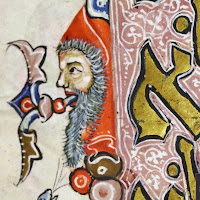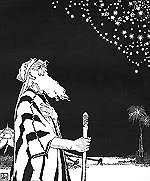Excerpts from a text by John Hodgson.[1]
We can analyse and classify marginalia in various ways: text versus imagery; contemporary decoration and annotation as opposed to later additions. However, one of the delightful aspects of marginalia is that they defy easy categorization. While some forms of marginalia were clearly planned, if not executed, by the original scribe or printer, the process of book production in manuscripts and early print cultures did not have a clear cut-off point: it was customary to decorate early printed books, for example, and the transition from production to reception was gradual and ambivalent. Likewise, it is not straightforward to differentiate text and imagery. Text can be embellished and elaborated into beautiful and bizarre forms. Flourished initials extend into the margins, while the top line of text may be decorated with flourishes and contorted into human heads.[2]

Detail from the Rylands Haggadah, Catalunya or Valencia, c. 1350. Sepharadic art. Hebrew illuminated manuscript (Manchester, John Rylands University Library, Heb. Ms. 6, fol. 29v).
Drolleries are amusing figures or scenes, often depicted in the margins of a manuscript, or within an initial letter. Grotesque[rie]s are fantastical or comic figures, often combining elements of human and animal forms. They are common in the margins of texts, either incorporated into the illumination, or added by early readers.[3]
Drolleries often occur in what would appear to be inappropriate contexts, and there are several theories to account for their presence in the margins of religious books, for example. They may have been intended to subvert or question the text, to serve as aids to contemplation and visual cues for memory and recollection, or simply to entertain bored readers.
Notes and references
1. John Hodgson, "Life on the Edge: Marginalia", John Rylands Library Special Collections Blog, 29.9.2013
2. Hodgson writes that cadels are decorative flourishes on letters, sometimes turned into human faces or grotesque shapes above the text.
3. They are sometimes called "Babewyns", Hodgson explains. Nonetheless, one may argue that such designation could not concern all medieval marginalia grotesqueries. Babewyns seems to have something to do with "baboons" and possibly relates to monkeys and apes (which also pertain to medieval marginalia).
Bibliography
Camille, Michael. Image on the Edge: The Margins of Medieval Art, London: Reaktion Books, 1992.
_____. Mirror in Parchment: The Luttrell Psalter and the Making of Medieval England, London: Reaktion Books, 1998.
Jackson, H.J. Marginalia: Readers Writing in Books, New Haven: Yale University Press, 2001.

See also
• Medieval Grotesqueries
We can analyse and classify marginalia in various ways: text versus imagery; contemporary decoration and annotation as opposed to later additions. However, one of the delightful aspects of marginalia is that they defy easy categorization. While some forms of marginalia were clearly planned, if not executed, by the original scribe or printer, the process of book production in manuscripts and early print cultures did not have a clear cut-off point: it was customary to decorate early printed books, for example, and the transition from production to reception was gradual and ambivalent. Likewise, it is not straightforward to differentiate text and imagery. Text can be embellished and elaborated into beautiful and bizarre forms. Flourished initials extend into the margins, while the top line of text may be decorated with flourishes and contorted into human heads.[2]

Detail from the Rylands Haggadah, Catalunya or Valencia, c. 1350. Sepharadic art. Hebrew illuminated manuscript (Manchester, John Rylands University Library, Heb. Ms. 6, fol. 29v).
Drolleries are amusing figures or scenes, often depicted in the margins of a manuscript, or within an initial letter. Grotesque[rie]s are fantastical or comic figures, often combining elements of human and animal forms. They are common in the margins of texts, either incorporated into the illumination, or added by early readers.[3]
Drolleries often occur in what would appear to be inappropriate contexts, and there are several theories to account for their presence in the margins of religious books, for example. They may have been intended to subvert or question the text, to serve as aids to contemplation and visual cues for memory and recollection, or simply to entertain bored readers.
Notes and references
1. John Hodgson, "Life on the Edge: Marginalia", John Rylands Library Special Collections Blog, 29.9.2013
2. Hodgson writes that cadels are decorative flourishes on letters, sometimes turned into human faces or grotesque shapes above the text.
3. They are sometimes called "Babewyns", Hodgson explains. Nonetheless, one may argue that such designation could not concern all medieval marginalia grotesqueries. Babewyns seems to have something to do with "baboons" and possibly relates to monkeys and apes (which also pertain to medieval marginalia).
Bibliography
Camille, Michael. Image on the Edge: The Margins of Medieval Art, London: Reaktion Books, 1992.
_____. Mirror in Parchment: The Luttrell Psalter and the Making of Medieval England, London: Reaktion Books, 1998.
Jackson, H.J. Marginalia: Readers Writing in Books, New Haven: Yale University Press, 2001.

See also
• Medieval Grotesqueries





